Ahoy, squirts! Quint here with my latest contribution to the AICN Legends column. Vic Armstrong might not be a household name, but a Legend he is. Beginning his film career as a stuntman with a specialty in horsework Armstrong has gone from being an evil ninja in You Only Live twice to the Man of Steel in Superman I and II to probably the biggest feather in his cap: Indiana Jones.
Not only did Armstrong show a talent for practical stuntwork, he’s also developed an eye for coordination and have moved deftly from being a stuntman to coordinator to second unit director (or action director as he prefers to call it) working today on the biggest studio movies, including his most recent job coordinating stunts and directing the action unit on The Amazing Spider-Man.
This man ran with Robert Shaw, drank with Oliver Reed, fought Zod, boxed the big Nazi under the plane in the desert, swung from a whip into a mine car and was blown out into oblivion while dressed as a giant devil.
In other words, Vic Armstrong might be the next in line for Dos Equis’ most interesting man in the world.
Hope you enjoy this rather lengthy interview in which we discuss Bond, Indiana Jones, Superman, Harrison Ford, Robert Shaw, CGI, the state of modern stunt work and much more!
Armstrong’s book THE TRUE ADVENTURES OF THE WORLD’S GREATEST STUNTMAN is a fascinating read and this interview is only the tip of the iceberg. I went out of my way not to cover a lot of the same ground, so if you like this you’ll flip your shit for the book.
UPDATE: The two winners are Chris Cardno and Matthew Suszka! I'm still giving away one copy on Twitter. Check my account to see how to win the third and final copy!
If you want a chance to win a copy of the book, well look no further. I have three copies to give away. I’m going to give one away on Twitter, but the other two are up for grabs by emailing me at quint@aintitcool.com with the subject line Vic’s The Man and your mailing address in the body of the email. The contest is open to anybody in the world, so email me! Hurry!
I’m going to be taking the first two emails I get, so lightning fast! Look for an update here when I get the winners’ emails! So, email me fast and then get your butt back here to read the sweet interview!

Quint: Before looking back on your career, I’d like to start with today. In the book you were very diplomatic when discussing CG, but seemed to indicate that far too many directors lean on that tool too heavily, especially when it comes to stuntwork. Why do you think many filmmakers today rely on CG stunts? Is it a safety thing? Are they lazy? Is it more cost-effective?
Vic Armstrong: I don’t think it’s a money thing because it’s still very expensive. I think it’s probably not knowing how to do it for real. There’s more and more people who find it difficult to stand on a set and say, “Okay, we’ll do this… have a truck come over the hill. In six month’s time when I come back we’ll have that building over there made to breakaway and this and that.” The foreplanning of knowing what you’re going to have to have when you do come back to shoot it.
You know, you put your neck on the line to a certain degree. It’s okay if you know what you’re doing and you’ve done it before, but I think there’s probably a lot of people who haven’t done it, so they say “We’ll do it in post!” Then they look at it and go, “I don’t like this, put the house over on the other side of the road,” and this and that. (CG) gives you the freedom to do that, which I think is bad. It then becomes a cartoon movie.
I love CG, as I mention in the book. It’s my Get Out Of Jail Free Card, it’s made life so much easier. You know, morphine is an incredible, wonderful drug if you need it. It has helped a lot of people in trouble. But overuse and addiction is a killer. I look at CG (the same way). Overuse and addiction to CG, doing it solely CG, kills sequences.
We’ve all seen that have been just as hurt by bad CG as ones that have been helped by good CG. It’s all in the application.
Quint: Do you think with the recent massive success of Fast Five, a film whose whole marketing campaign revolved around big, real stunts, that studios might turn away from their more CG-intensive stuntwork?
Vic Armstrong: I think that started already. The last few films I’ve been involved with, Green Hornet, Thor and now Spider-Man, the first thing said when we go into meetings is “We want make this as real as possible. We don’t want it to look like a CG fest,” etc, etc.
We spent weeks and weeks on Spider-Man getting Andrew Garfield and the stunt doubles to fly for real rather than just having cartoon characters whizzing around the screen. There’s some great stuff on YouTube of Spider-Man flying down 12th Ave. underneath this big, gothic archway, viaduct.
There’s a whole resurgence in doing things for real, which is how we like to do it. I’m not kidding people… we don’t cheat, but we don’t do things for real in the movie business. You don’t jump off a hundred foot building, land and walk away from it, but we can make it appear that you can. We’ve always used different tricks in the past, whether it be a stuntman landing on boxes and, with clever editing, you cut and see him land on the road. Things like that. To me, that’s no different to using CG in a movie to take out a pipe-ramp or to take out an airbag that you’re falling towards.
>Quint: With the advent of DVD and the easy access to behind the scenes material on TV, DVD, books, etc, I think the average movie-goer is more aware of what’s going on behind the curtain than they used to. Using a combination of CG and real effects or stunt work makes it harder for the audience to spot the gag.
Vic Armstrong: Absolutely. When we did the last bit of flying down in New York… We had fifty cars as he’d be flying above, swinging through as they’re driving up and down the road. Even the people in the cars who have seen it two or three times, you could see them looking out the windshields going “Whoooaaaa!”
Avi Arad, the producer of Spider-Man and he did all the other three Spider-Man (movies), he said “Oh my God, Vic. This is exactly what you said you guys were going to do!” My guys being myself and my brother Andy, who is the stunt coordinator with me. He said, “This is exactly what you said! It looks so different!”
When Spider-Man swings from one direction, then turns to swing another direction he’s pulling at 2 to 2 ½ Gs. That’s a lot of pressure on his body, but you see that on the body. You see the arms straightening out, you see the legs straightening out and then he pulls them back up as he then goes back up into his flying position.
You sense, subconsciously, the realism. You know. The eye and the brain is a funny thing. You only need something slightly off kilter for you to say, “Oh! Alarm-alarm-alarm! Something’s not right!” If somebody has one eye a quarter-inch higher, it’s not a lot, but straightaway the whole thing is out of balance and you see that in CG. When you see somebody swinging for real, then you look at the CG version your computer brain instantly tells you which is which.
Quint: Are you wrapped on The Amazing Spider-Man?
Vic Armstrong: I wrapped on Friday, yes. I’m going home to do a little publicity for the book, play a little golf and then I’ll be back!
Quint: How was that experience overall? Did you find it rewarding? From the man-on-the-street pictures and videos that have been coming out it looks really sharp from my perspective.
Vic Armstrong: I’m very, very happy with it. We did everything we set out to do and that’s all you can ever hope for. I’m very, very pleased with what we attempted and what we achieved. I really think it’s going to be a good movie.
It is a reboot. They don’t like to call it that, but it is a reboot. We went in at ground level and just changed everything; changed the actor, changed his approach to it and got some great, realistic modern parkour, skateboarding, flying… everything in it.
Quint: I’m a big fan of Andrew Garfield being cast in that role. I’ve loved his stuff in since seeing Boy A and the Red Riding films. Can’t wait to see what he does with it, but I think he’s going to make a great Peter Parker.
Vic Armstrong: Yep. They were very, very shrewd in their casting, I must say. They made a great choice there.
Quint: So, what was your role in SPIDER-MAN? Where you the second unit director and stunts?
Vic Armstrong: Yeah. Because of my history, obviously, I’m the action unit director and the stunt coordinator, but I always work with my brother Andy or at least I have the last few years. He’s a second unit director and a writer and a stunt man in his own right and he’s directed his own movies. He directed MOONSHINE HIGHWAY; he wrote and directed it. So we are very close; we know each other’s work. We are obviously both experienced and we like to think we can do things practically and economically. We are great believers in rehearsal time, so while I’m prepping my unit or talking to people, Andy has got a whole studio… We had a big stage based down in Culver City where we set up rehearsal areas for flying and fights. He gets all of the fight guys and the doubles in and works out ideas and then he will video them and come and see me and we will go see Marc Webb, the director, and so he’s instrumental in putting it all together.
It was just a whole team effort. You know, we are all tiny little cogs in a great big machine. We like to do what we’ve been asked to do and then give them a little bit more as well; give them alternatives and say “We could do that, but we could also do this version where you could do it like this” and suggest things and then we find the right people to do the job. It’s quite a democratic job, but you know you need to know what you are doing to be able to do it and do it economically. You have to stay within the budget and things like that, you know?
Quint: Yeah.
Vic Armstrong: There are all sorts of politics you have to deal with as well.
Quint: Well, I would like to move back a little bit. One of my all time favorite actors is Robert Shaw and I noticed you worked with him a couple of times. You seemed to get along with him from what I can tell in the brief mention in the book. What was your impression of Shaw?
Vic Armstrong: I loved him. He was your typical hellraising actor of the era when we were working together in the 60s. He was wonderful and a great athlete. He used to run for the Amateur Athletic Association in England and was a practical joker, a heavy drinker, a huge drinker in his day, and so therefore he would have some wild times as well. I even mentioned in the book where one day I was in Spain and (laughs)… He looked at me and sort of took me as a bit of a challenge because I could run and so he challenged me to a race and I ran and he ran. It was on camera, but it became a competition between he two of us. As we pulled up, he just vomited all of this red wine. (laughs)
He was a hell of an athlete because he was running with a belly full of wine as well; I only just beat him! It was great times. Wonderful man. He was great to me, he really was. He was very, very nice. I was a very young man at that time, so it was a pivotal point in my career. (Figures in a Landscape) was the first thing I stunt coordinated and I sort of got it by default, because the stunt coordinator that was on it left to go do KELLY’S HEROES, so it was a big important film for me, so it was great not to have an actor that took advantage of you, that treated you as an equal and it was just wonderful.
Quint: Especially somebody like Shaw. I imagine he didn’t suffer fools, so if he didn’t like you then you would know that was your fault.
Vic Armstrong: Oh my God, yeah absolutely, but he was brilliant, absolutely wonderful, you know?
Quint: It’s kind of almost a missing breed. We don’t have too many Robert Shawes, Richard Harrises, Oliver Reeds… We don’t have too many of those kinds of guys around any more.
Vic Armstrong: We don’t. It’s strange; they are gone. I don’t know what it was, whether it was the era that they great up in or whatever, but you are right they were men’s men, women loved them, and they were hellraisiers and they didn’t suffer fools you know? They were foolish at times and I’ve been foolish with them many times! (laughs)
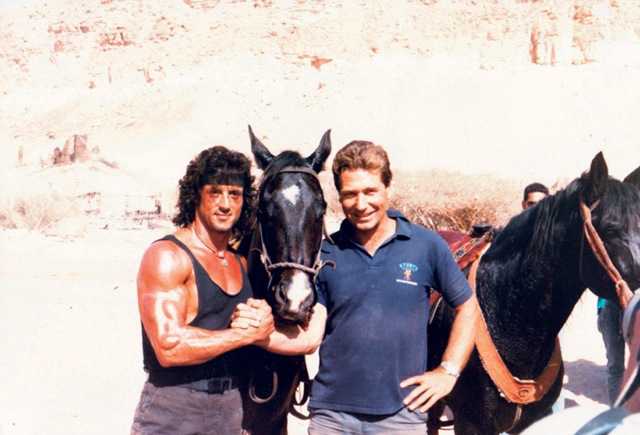
Quint: Some of my favorite stuff that was in the book was your recollections of working on SUPERMAN I and II. Dick Donner and the team seemed to be behind pushing the limits of the technology of the time. I mean, the whole marketing campaign was “You will believe a man can fly” and that seemed to be the big challenge of the movie, to make that as realistic as possible. To this day I still watch those first two movies and it astounds me. That initial flight, which I believe you say was actually you, when flying from the Fortress of Solitude the first time you see Superman in costume… where he just flies towards camera, then banks past camera. I can watch the making ofs, I can see how that works a million times, but to me that’s movie magic. I watch it and I still don’t understand how that happened. (Laughs)
Vic Armstrong: It’s stunning. I did a lecture at The British Film Institute and they showed clips of all of my films and that was one of them that came up and it still stands the test of time. It’s a brilliant movie… just a stunning movie. In the book I stand corrected, somebody has written to me. I said that it was Non that threw me into the Marlboro truck, but apparently it wasn’t. It was Zod. When we were shooting it I had no idea who it was because they weren’t even there.
Quint: Yeah, your part was just crashing into the Marlboro truck. (Laughs)
Vic Armstrong: “You run up the ramp and throw yourself into it.” Months later they did the throw, so I was wrong on that one, but I knew it was one of the people from outer space that had thrown me into it.
Quint: At least you didn’t say it was Lois Lane!
Vic Armstrong: That a great film to work on and Dick Donner you know brought so much style and panache to it. It was wonderful. I worked on it in New York. It was my first trip to America on that and I’ll never forget stepping out of the trailer with the cape on and the tights and walking over to the set people (to put me up) on wires to fly up 56th and 5th Ave. in New York. It was three o’clock in the morning there must have been two thousand people there just waiting to see Superman. They were screaming and it wasn’t even Superman, it was me! The passion it ignited in people was just amazing.
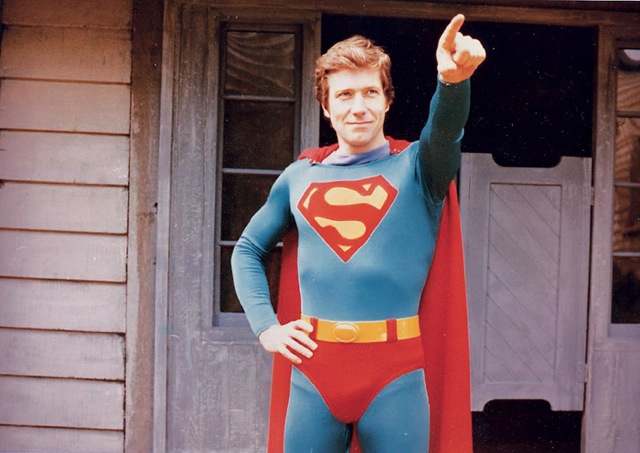
Quint: He was an icon. You must have felt like a rockstar.
Vic Armstrong: (Laughs) It was great.
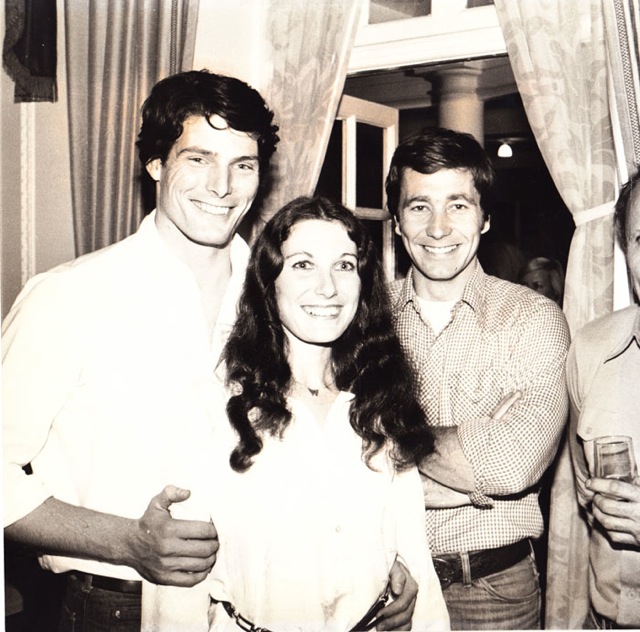
Quint: Sorry Chris [Reeves], I get to be the star right now.
Vic Armstrong: Yeah, exactly. It was fun, but you never loose sight that it’s all a game. It’s just a movie and it comes and it goes, but you do give it your all. You give it your best shot every time you shoot it, you know? Every movie you work on is the most important one you have ever worked on in your life and whether it’s a success or not you don’t know that at the time, you just give it your best.
Quint: I’d argue a little bit with you on that one, because when a movie hits as strong as Superman or the Indiana Jones films or the Bond films, it doesn’t go away. It’s kind of permanent and becomes part of pop culture. It stays.
Vic Armstrong: It does and even more so now with the advent of DVDs. They are wonderful things. Every chance I get I do a little talk on the special editions of them and things like that because I think that stands there forever. It’s a wonderful thing for kids or grandkids or whatever you know?
Quint: Yeah, I love it as somebody who grew up such a movie fiend I had dreams of having my video store. I had dreams of having my own film collection and now I’ve got two thousand plus movies at my beck and call plus Netflix! It’s an amazing age for film lovers I think.
Vic Armstrong: It’s amazing. I’ve got a cinema built in my house at home. I used to have this big saddle room and the saddles outgrew it, so I built a new saddle room for them and I put this 30’X16’ cinema with theater seating and 7.1 THX and all the rest. I’m in the Academy, so every Christmas I have the most amazing season of screening movies. It’s just brilliant.
Quint: Being a film critic, they send Academy screeners for voting, so it’s like I probably don’t get everything that you do, but I get quite a bit and it is a kind of amazing time to sit back and just kind of go over what came out in the year.
Vic Armstrong: It is, but it also makes you realize there’s a lot of bad films out as well as good films and everybody that started off on those films are making the best film in the world and I can see stories behind them all; it’s quite interesting.
Quint: I think it was a famous Kubrick quote. He apparently watched pretty much everything that came out and then people were like “Why do you go watch all of these horrible movies?” He said, “Well I learn more from a bad movie than I do a good one.”
Vic Armstrong: I agree.
Quint: I imagine as the second unit director you have to try to make it just like your stunt work, your stunt coordination work; you have to make your work blend with the main unit or else you didn’t do your job. If people can spot the break…
Vic Armstrong: It’s like being a counter feeder, you have to copy it exactly.
Quint: Exactly, so do you tend to notice it now that that’s your main job? Do you notice in movies where you go “Well that’s obviously second unit…”
Vic Armstrong: Yeah, I can look at movies and see where second units kick in and I live and pray that never happens on movies I work on! When you look at TOTAL RECALL or UNIVERSAL SOLDIER or STARSHIP TROOPERS or THOR or these big movies, I can’t see the seam which is a big part of the job. It’s something you mustn’t ever look at as an add-on to a movie, but I do look at other movies and notice it. It makes you aware of it all of the time that you must never let your guard drop and do things just for the sake of doing it or doing it just because you want to do it that way. There are a lot of limitations you have to abide by.
Quint: What are the tell tale signs for you of shoddy work like that?
Vic Armstrong: I think it jars, when it looks totally different. There’s a certain beat and a rhythm to a movie and when that rhythm gets changed and the camera style changes… It’s more in the style probably with the lighting although the lighting can be corrected in post with timing and everything else, but it’s with the camera movement, the camera styles and things like that when it goes from the crane move to a shaky move or something like that that’s not fluent throughout the rest of the movie. It’s stuff like that that stands out.
Quint: Well we’ve got to talk a bit about INDIANA JONES because those were (and still are) massive films for me growing up. Obviously the cover of your book is you from TEMPLE OF DOOM and it seems just from my perspective reading that due to circumstances with Harrison’s back injury that you had a little more work in TEMPLE OF DOOM, a little bit more responsibility in helping the movie continue on while Harrison was recovering. Is that true or is that just my impression?
Vic Armstrong: Oh yeah, you know I came to work one day and Harrison was on a plane back to the states with this terrible back problem, poor fellow, and Spielberg with due credit to him said “Well, lets shoot on Vic.” They kept shooting on me over my shoulder and three quarters from behind and what have you. We shot a lot of the mine cart stuff and the fight on the conveyor belt with the stone crusher and all of that sort of stuff, but give him his due, as soon as he came back Harrison was thrown straight into it and did all of the his fight parts straight away, so we threw him in the deep end.
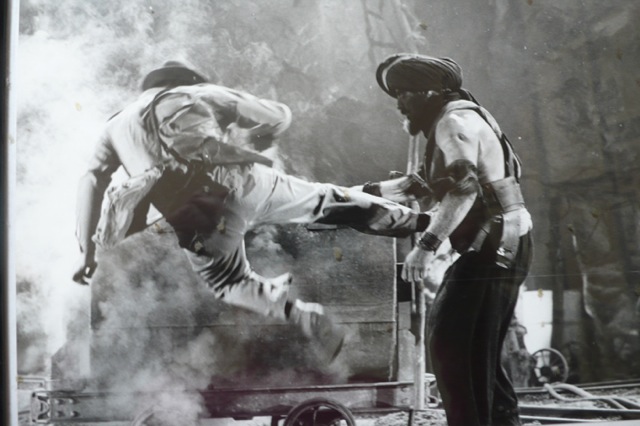
He’s a great guy and he wants to be Indiana Jones and it is him, he is the character, he is Indy, you know. There’s no question about it and that’s why he wants to contribute as much as he can to it because he wants every ounce of it that he can put into it to be him. He’s great as the character.
So yeah it was a big responsibility, but they were three wonderful films to work on and I will forever proud and grateful that I was at the top of my game in physique and everything else at that time. It was just fate. If it was ten years before or ten years later, somebody else would be sitting here talking to you.
Quint: I’m pretty good at spotting stunt performers in movies, I guess because I love the behind the scenes stuff so much and I pick apart movies… I’m kind of obsessive about it. I’ll notice when someone rolling down a hill has their arm perpetually over their face and recognize it’s a stunt performer. I’ve watched those first three INDIANA JONES movies a million times and I don’t have that moment with any of them.
Vic Armstrong: On TEMPLE OF DOOM there was one funny moment… Just prior to dropping into the mine cart when he’s released all of the children, he swings towards camera, literally full face towards camera, then lands and then turns and after that then goes down and ends up in the mine car. Have a look at that one because that’s me. It’s a quick shot, but it’s full facial right at camera, (laughs) but we get away with it.
Quint: Is that the epic swing where all of the bullet hits are going off and then he swings all across the whole set? Is that what you are talking about?
Vic Armstrong: Yeah, it’s the end of that where he swings right towards camera, comes through the guard rail and lands on the walkway above and then is in the mine cart and goes down into it, yeah.
Quint: That’s awesome; I’ll have to rewatch it. I’m actually a huge TEMPLE OF DOOM fan. I love that movie. I know that Spielberg and Lucas aren’t all that hot on it when they talk about it now because for them apparently it was a darker movie and that represented where they were in their lives at that point, but I don’t know…
Vic Armstrong: I’m with you, I love it. I think it’s great and it made a great trilogy. You wouldn’t want them all to be the same and it was all a great change in tempo. It was great.
Quint: I feel it’s the only INDIANA JONES sequel that’s not chasing RAIDERS OF THE LOST ARK, you know what I mean?
Vic Armstrong: Yeah, exactly.
Quint: It was so content to be its own thing and to have a completely different tone and feel, but also out of all of them I think is probably the most high adventure. It doesn’t travel the world as much as something maybe like LAST CRUSADE, but it just feels like it’s out there to have fun. “We are there. We are going to have fun. We are going to have this epic hero kicking ass.”
Vic Armstrong: They were great characters with little Short Round who was wonderful, he was a great comic edge. It was great. I had fun on it as well. We started off in Macau, then went into Sri Lanka… It was a great trip. (Laughs)
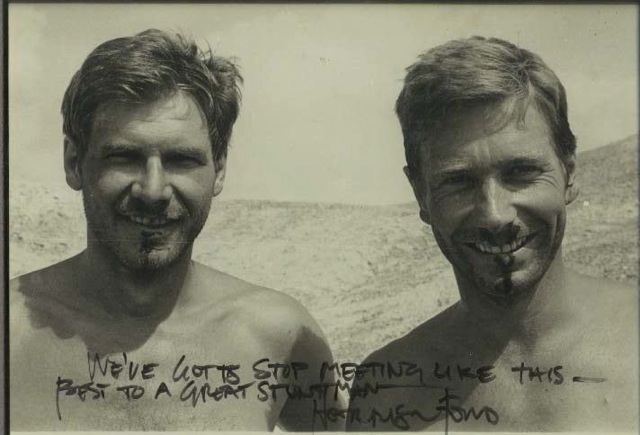
Quint: I would imagine. We talked a little bit earlier about modern stunt work. I was very happy to see you acknowledge in the book was when you were talking about ONG BAK and ONG BAK 2. I think it’s because there had been such a lack in Hollywood films, western films, of great person on person stunt work that when you watch something like ONG BAK it feels so raw. It feels dangerous. My friends and I have a theory, you know how in that movie they will repeat a stunt, where the bigger the impact or the hit or whatever you will watch it cut from like three different angles. Do you know what I mean? My friends and I had a theory that they did that every time a stunt person died. They were like “We killed him obviously when we rammed this dude’s head through eight walls, so we are least going to give him three or four different angles to commemorate it.” Are you always on the lookout for the newest thing?
Vic Armstrong: (laughs) Oh yeah, 100%. I love the fighting style, it’s Muay Thai with realism. I love that and they are all my mates on ONG BAK. I’ve done twelve or thirteen shows in Thailand, I know all of the boys out there and they are wonderful. I’ve actually brought them to the west and don shows with them over here; they are fantastic performers, wonderful people, polite, great athletes, and very inventive. I just love working there.
I would love to direct a Thai movie, actually, or an Indian movie and bring it to the west because ONG BAK sort of made the breakout, but I thought you could go further with that type of thing, with that type of character, and you can meld the two together, the east and the west and do what we did with Jackie Chan. I think we could come up with something really good.
Quint: That would be great. You need to go do that. I would be totally on board.
Vic Armstrong: (Laughs) I’m actually going to India probably to have a talk about a job in the near future because I’ve done a couple of Bollywood movies and they are desperate to do that and the time is right and we are always looking for something new and I think that would be the new thing, you know?
Quint: If you look historically action has been able to bridge foreign films to mainstream American audiences. When you look at the influx of kung fu movies or chopsocky movies, after Bruce Lee and then you look at Jackie Chan’s movies being brought over and working so well. Or look at Crouching Tiger Hidden Dragon, which was a hug box office success here. I think when you look at it historically it has been the ability to sell the stunt work and to sell the action and that’s something that you have a great talent for, obviously. You have made a career out it and you have had such a great eye that I think that would be perfect for a Bollywood film that can play well over here.
Vic Armstrong: I think it would. I think the audience would love it. They would eat it up and it’s fresh and new. I think it would be great. So that’s in the works, who knows? It’s a long road before you ever get it to fruition, but you never know.
Quint: You also worked on another movie that was a favorite of mine growing up and that’s LEGEND. You mentioned in the book that you doubled Tim Curry, is that right?
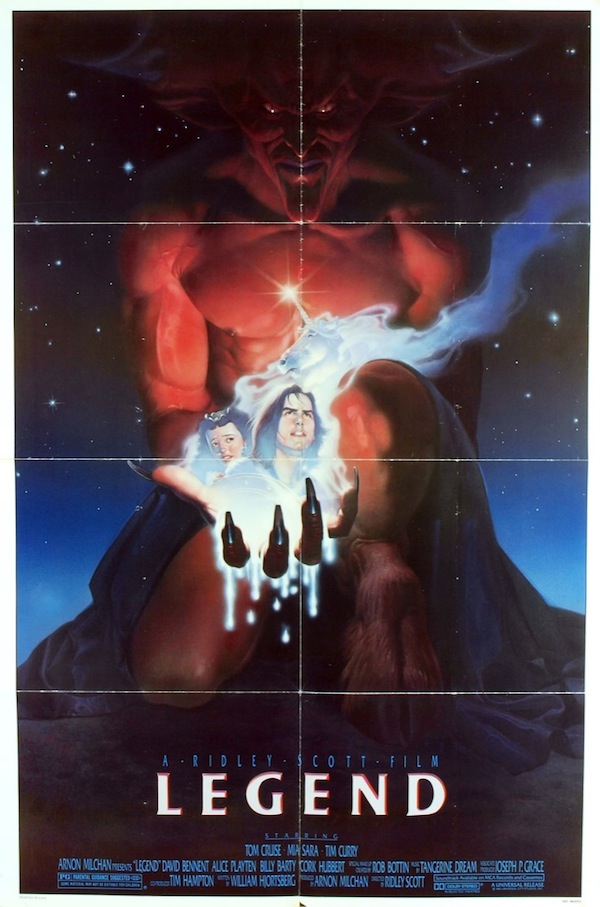
Vic Armstrong: That’s right, the Lord of Darkness, yeah. (Laughs)
Quint: So you had to get in all of that makeup?
Vic Armstrong: Yeah, oh my God it was so hot! With all of the draping… ugh! It seems like a lifetime ago, but again a great movie with a great contribution. I had a great scene with Mia (Sara) and went to Spain and bought some fabulous horses and everything else. It was an interesting movie, it wasn’t probably quite the hit it could have been, but it still is used as a benchmark for style and things like that you know. I’m very proud of what we did on it.
Quint: It’s got a very bizarre tone, but I think that for all of the reasons why it kind of misses are kind of the reasons why I like it in a really weird way. It’s at least not trying to be the same old thing. It swings for the fences and I give a movie a lot of points when it does that whether or not it knocks it out of the park.
Vic Armstrong: Exactly, exactly.
Quint: How was doing stunt work in such a complex makeup? Did that change your approach to it at all? Did it hinder you at all or did it help you?
Vic Armstrong: It was tough, but everything was worked out in advance and it was just horrible sitting in that damn suit dehydrating. It was the most bizarre situation, but I’ve a knack I can just switch off and I just had one of those boards… Have you ever seen on the sets of those period films where you have a vertical board with the two armrests and you just lean against it for the ladies when they are wearing crinolines? So I had one of those boards and I would be just leaning there and they would have to tap on the board to wake me up. I would be fast asleep standing up leaning against this board with my arms on the armrest. It as just a switch off to get out of the environment, you know?
Quint: One of the big things about the Darkness costume are the horns and you talking the book about pioneering a device where you had a 35mm camera mounted on your helmet for some riding shots and how dangerous that was, that if you had fallen the wrong way it could have taken your head off. Were the horns something similar like that? Were they heavy? Dangerous?
Vic Armstrong: They weren’t too bad actually. It was very, very heavy. It was latex rubber and they’ve got to be heavy rubber so they don’t bend, but it wasn’t too bad actually and in the end where he gets fired out into space I was literally on a track, on a chair on a trolley and they had a ram that just fired this trolley down the track a bit like a sort of launching sled for rockets you know. I went rocketing back and when he came to the end and I hit the end, the chair stopped and flipped over and I went off into space! Literally. I was wearing the whole thing and it didn’t wrench your neck around. It wasn’t that dangerous actually, it was just more uncomfortable and bloody hot.
Quint: Something in the book that I didn’t see you mention… I might have overlooked it, but I saw that you worked with Terry Gilliam on BRAZIL; is that right?
Vic Armstrong: Very briefly, yeah there was a sequence where we were repelling down in some disused electrical powerhouse up in London. It wasn’t a great moment for me. It was more of an example of how you go up for a job, no matter if you are the stunt coordinator on LEGEND or the unicorn trainer or whatever and you still go and get your day’s work on another film. A pal of mine was coordinating it and pulled me in and you know nothing’s too big and nothing’s too small, you go along as a professional, so that’s what you go and do. You don’t get any ego about it all and be happy for the work.
Quint: So that was more of like a day player gig?
Vic Armstrong: Exactly.
Quint: It seems to me the big three for me from reading the book seem to be SUPERMAN, BOND, and INDIANA JONES where it’s like those were almost like legacy projects for you. You almost began your career on a Bond movie and you’ve touched upon Bond through almost every iteration. I think the only ones… You didn’t work on and of the Dalton BONDs, right?
Vic Armstrong: No I didn’t no, but it’s been a great series for me. I remember seeing DR. NO before I was in the film business and the effect it had on me and then to wind up on YOU ONLY LIVE TWICE I bought my first car on it with 90 pounds, about fifty bucks for a car and to me it was just such an honor to work on a Bond movie. It was like “Oh my God, I’m on a BOND.”
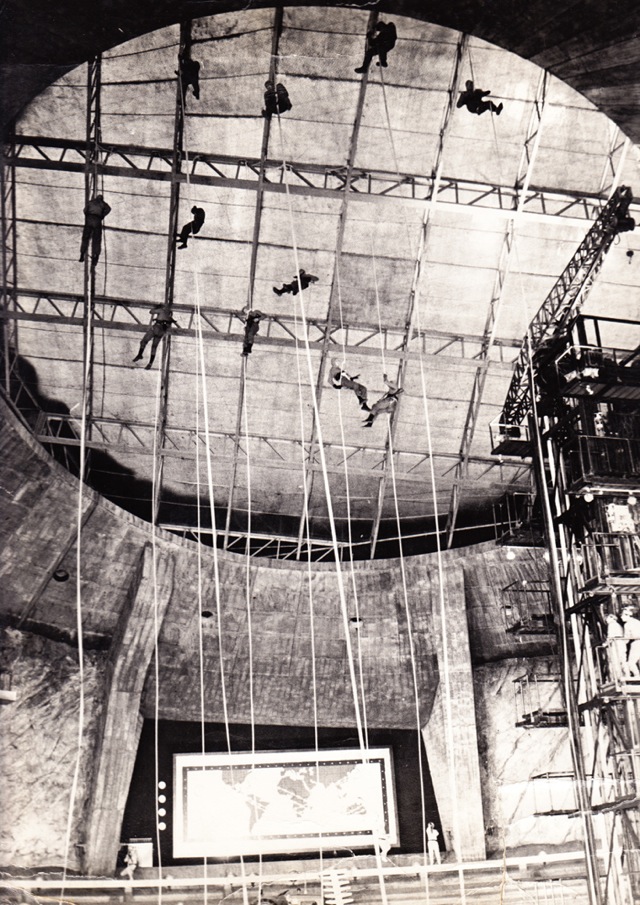
Then in the later years cut all the way to the end of the chase and I’m now directing and writing and choreographing millions of dollars worth of film for these people. To me, I’m so proud of it because I’ve worked my way up from that, from being just a regular day-playing stunt man invisible amongst the others to being the job that I had. I think it’s a fantastic thing and I’m so proud of it and I’m proud of the series, the whole films.
Quint: And it seems like your work, especially on the later ones, is so integral to actually making them what they are and upping the ante… No matter what you think of anything else in Die Another Day, that balletic car chase on the ice is an amazingly shot action sequence.
Vic Armstrong: I’m so proud of that one because again you turn up and they say “Alright there’s a chase on an ice lake” and you think “What the hell am I going to do? Two cars chasing each other, there’s no numbers to jump out of the way as they are crossing the road… There’s no cars to push off into a gas station to blow up… There’s nothing to play with!” I went out there and I looked at the location and it sort of spoke to me. Rick Carter the wonderful production designer who did AVATAR and WAR OF THE WORLDS and things like that, we were looking one day on WAR OF THE WORLDS and I couldn’t see what I wanted and he said “It’s not talking to you, is it?” I said, “Excuse me?” He said “The location, it will talk to you when you find the right one.”
When I got to that lake it talked to me and I could see these great big icebergs and the sun came out and melted all of the sort of soft velvet like snow off the top and just revealed all of this wonderful blue ice and I thought “That’s what we will do.” I could see it with classical music and it was just a big dance, a violent dance, for these cars both with the same amount of power, the same amount of skill, the same amount of armaments and it was a duel between these cars like a classic movie with the big sweeping wide shots and things. I just had this wonderful vision where you are like “Hey! That’s what the film business is all about.” I’m so proud of that piece, it worked out beautifully.
Quint: It seemed to give you also a little creative freedom to do something just a tad different. That’s what I think really makes the sequence stand out, it’s not the typical Bond sequence and it’s not the typical chase. It’s not something we’ve seen. It seemed to give you a license to play a little bit more you know?
Vic Armstrong: It certainly does and to me that’s the secret of all of these sequences. You mustn’t go “Oh here we go, it’s a rehashed version of so and so…” Each one is a different take and a totally different thing and that’s the toughest thing, coming up with that originality. Eventually the location will spur a thought in the mind and away you go. It’s important to keep all of these things fresh and new and different.
Quint: Since you have a unique perspective on the Bond movies from back in the Connery days to almost current. You have worked with Daniel Craig, but you haven’t worked with him on a Bond movie yet, but since you have such a unique perspective on all of this, how has it changed for you? Has there been a massive evolution of the franchise that you’ve seen from your perspective?
Vic Armstrong: I think Barbara Broccoli and Michael Wilson… I think their trust in people like myself to let you go out there and do it… You have parameters to work to. I gave a speech at the film school in London for Cubby Broccoli’s 100th anniversary of his birth… we was dead of course, but it was his hundredth anniversary, and they let me show any Bond film I wanted and then did questions and answers afterwards. Before that they had a screening of DR. NO, a new revamped screening, and it was amazing watching DR. NO, if you ever watch it again, to see the formula there. There’s such a formula that we all adhere to unconsciously, it’s always in the script and the moments are there, but it’s wonderful how it has modernized. It’s kept up with modern times.
That’s the tricky thing, they have kept this wonderful formula like a Harold Robbins book has a formula, Bond has a formula, but they kept modernizing it and modernizing it. I know George Lazenby was sort of assassinated as Bond because I think the general public couldn’t stand the thought of anybody else being Bond. But they survived that. Roger Moore came in and was loved and I think whoever would have played the part, whether it was George Lazenby or anybody else, they would have had to be the sacrificial lamb. Somebody had to be slaughtered for taking Sean Connery’s job. It didn’t matter who it was, they would have had the same fate, but they revamped it and they got Roger in and they got Timothy in and so on and so forth and they’ve kept moving towards it with the times.
I think it’s a brilliant feat. How they do it I don’t know. Maybe because they do have fresh people in there all of the time and they come up with different ideas, but they are the easiest company in the world to work for. I just adore working for them and they give you total freedom. You know, I wanted over a million pounds, one and a half million dollars plus to get those cars changed to four wheel drive, so that car chase could be (pulled off). They were like “Is there any other way you can do it?” I said “No, if you want the car chase there, this is what we need to do” and they asked me again and I was like “No, no if you want the chase… I would love to do it cheaper, but with two wheel drive the ass will be overtaking the fronts all of the time. You would never get anything with the speed.”
They said “Okay, go for it.” I did it and I found the location and went off to Iceland and I actually invited Michael Wilson up, because they leave me alone when I’m shooting. They just let me go off and shoot and shoot and Michael Wilson actually came up and stayed with us for a few days. It was a wonderful time and he thoroughly enjoyed it, but it was more to appease me than to see what I was doing or keep an eye on me. They are just wonderful people who gave me total freedom and I think that reflects in the movies.
Quint: Would you work on one of the Daniel Craig BONDs if they called you up?
Vic Armstrong: Oh absolutely. At the drop of a hat. But you also have to respect the directors. It’s a huge responsibility for the director. His neck is on the line and they want their comfort zone of people that they know and what have you, so it’s all done for various reasons and I quite understand it and I’ve done the same myself in the past, but I would love to work on one.
Quint: Just speaking from a viewer’s perspective, hearing that you were on board the next BOND movie would make me smile. Something that I’m really glad that you touch on in your book as well are the movies that almost got made and didn’t or sometimes they shot for a weak or two and then the funding was pulled because there isn’t a whole lot of coverage on movies like that. You mention specifically that Oliver Reed movie…
Vic Armstrong: NEW SPARTANS.
Quint: The NEW SPARTANS where I’m just like… I’m reading the cast and I’m like “Holy shit I’ve never heard of this movie, I’ve got to go find it and then I read a little bit further and go… ‘Oh, I guess I can’t…”
Vic Armstrong: It’s funny and it’s interesting because a lot of people have worked all of their lives in the business and have no movies go belly up, but I guess because I’ve done so many with the law of averages you are going to get one or two. Yeah, I’ve been on a few of them.
Quint: The one’s that the most interesting to me is CRUSADE with Paul Verhoeven and Arnold Schwarzenegger and that’s kind of a legendary movie for fans of those two. How far along did that get?
Vic Armstrong: Oh, we got into production design and all sorts of things you know. Yeah, that was way down the line. We hadn’t built sets or anything, but we were pretty much into it for a long time talking about crews and how many people he wanted and all of that sort of stuff and planning it and starting to get wardrobe looked into and stuff like that. But (Verhoeven) called me and said “It’s north of $120 million,” which in those days was phenomenal and that was it. I was very disappointed because I had actually turned down BRAVEHEART to do that as well, so that’s a shame.
Quint: That would have been great, especially with your expertise with horses and all of that stuff. That was going to be a project suited for you, but then I guess if CRUSADE, if it had gone, would have been very similar and you would have had…
Vic Armstrong: Oh yeah, that was going to be enormous, CRUSADE, absolutely massive.
Quint: And I love the scene that you describe in the book, which I had never read before. I’ve never read the script, but the scene of Schwarzenegger somehow being stuffed in a donkey, his head sticking out of it’s ass?
Vic Armstrong: Oh, it was hysterical.
Quint: With Paul Verhoeven doing that and his sense of humor it seems like such a sad loss for movie geeks.
Vic Armstrong: It would have been an unbelievable movie. (Laughs) It’s so sad it never happened, but there you go. It will come back one day I guess.
Quint: Thank you so much for taking the time, I really appreciate it.
Vic Armstrong: My pleasure. You certainly know your movies.
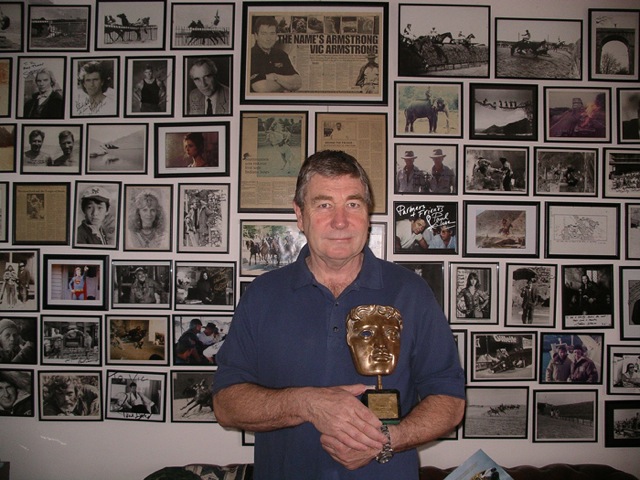
Thanks very much to Mr. Armstrong and Titan Books for this interview.
If you missed out on the email contest, be sure to join me on Twitter where I’ll be picking at random from those who retweets my link to this article as the third and final winner of this book!
Look for my next AICN Legends interview with the great Michael Biehn… it’s epic, well over 2 hours long. Gonna be a massive one!
-Quint
quint@aintitcool.com
Follow Me On Twitter

